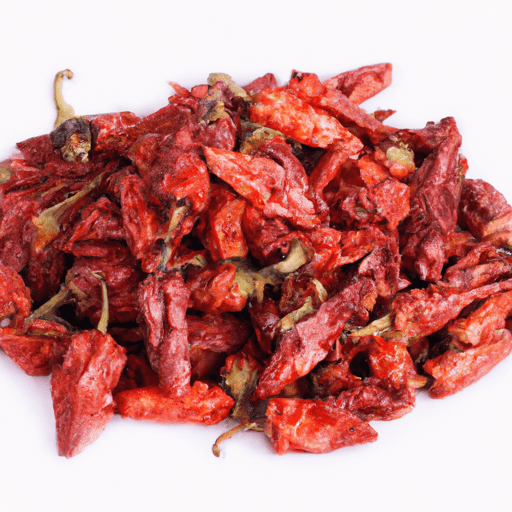Discovering Aleppo: A Culinary Adventure
Nestled in the charming landscape of northern Syria, the city of Aleppo holds a treasured place in the culinary world. With a rich history spanning thousands of years, Aleppo has become renowned for its vibrant food culture, where flavor is celebrated and traditions are honored. Join us on a culinary journey as we explore the distinct taste, versatile uses, nutritional value, and fascinating history of Aleppo.
A Symphony of Flavors
The culinary essence of Aleppo can be described as a harmonious symphony of flavors. A renowned ingredient that defines this ancient city is Aleppo pepper. Also known as pul biber, this chili pepper offers a unique taste profile. It strikes the perfect balance between mild spiciness and fruity undertones, with hints of cumin and even a subtle smokiness. The result is a depth of flavor that elevates any dish it graces.
Versatile in the Kitchen
Aleppo pepper is an incredibly versatile spice that finds its way into various dishes, both traditional and contemporary. It is often used as a finishing touch, sprinkled over roasted vegetables, grilled meats, or hearty stews. Its vibrant red hue adds a pop of color to any plate, making it as visually appealing as it is palate-pleasing.
But Aleppo pepper doesn’t stop at enhancing savory dishes. Its sweet undertones make it an unexpected but delightful addition to desserts. Imagine indulging in a rich chocolate truffle, only to be surprised by a subtle kick of warmth from Aleppo pepper. It’s a true testament to the spice’s versatility and adaptability.
Nutritional Value
Apart from its exquisite flavor, Aleppo pepper also boasts several nutritional benefits. Packed with vitamins C and A, it offers an immune system boost while promoting healthy skin and eyesight. It also contains capsaicin, a compound known for its anti-inflammatory properties and potential metabolism-boosting effects. So, not only does it make your taste buds dance, but it also contributes to your overall well-being.
A Tapestry of History and Culture
While Aleppo pepper is undeniably beloved today, its historical significance stretches back centuries. Aleppo was once a bustling hub along the Silk Road, a trade route that connected the East and West. As goods from around the world passed through the city, Aleppo became a melting pot of flavors and culinary traditions.
Centuries later, Aleppo’s unique cuisine continues to capture the essence of its extraordinary past. However, in recent years, the city has faced unrest, resulting in the displacement of its people and disruption to its food culture. Despite these challenges, chefs and food enthusiasts around the world are working to preserve the culinary heritage of Aleppo, ensuring its extraordinary flavors are enjoyed for generations to come.
Embark on Your Own Culinary Adventure
Embarking on a culinary adventure through Aleppo is an invitation to explore the historic flavors of the Middle East. Whether you sprinkle Aleppo pepper over your favorite dishes or experiment with traditional Aleppo recipes, you’re sure to be transported to a place where history, culture, and taste converge.
So, why not introduce a touch of Aleppo to your kitchen? Let the unique flavors of this ancient city inspire your culinary creations. Celebrate the rich heritage, savor the distinct taste, and honor the resilience of Aleppo through the power of food.
Origin and History:
- Aleppo pepper, also known as Aleppo chili or pul biber, is a variety of chili pepper named after the northern Syrian city of Aleppo.
- It is believed to have originated in the region thousands of years ago and has been cultivated there for centuries.
- Aleppo pepper became popular in the Ottoman Empire and has since been widely used throughout the Middle East and Mediterranean regions.
Common Uses:
- Aleppo pepper is often used as a spice to add flavor and heat to various dishes.
- Its fruity and slightly smoky flavor profiles make it a popular choice in many Middle Eastern and Mediterranean cuisines.
- It is widely used to season grilled meats, poultry, and kebabs, as well as in tomato-based dishes, stews, and soups.
- Aleppo pepper is also used in traditional dishes like muhammara, a red pepper and walnut dip popular in the Levantine region.
Nutritional Benefits:
- Like other peppers, Aleppo pepper is a good source of vitamins, minerals, and antioxidants.
- It contains capsaicin, which is known for its potential benefits, including pain relief and metabolism stimulation.
- The presence of vitamins A and C in Aleppo pepper contributes to its potential immune-boosting properties.
- It is also believed to have anti-inflammatory and anti-cancer properties, although further research is needed to confirm these.
Unique Properties and Significance:
- Aleppo pepper has a unique balance between mild heat and fruity flavors, setting it apart from other chili varieties.
- It is known for its vibrant red color and its distinct aroma, which intensifies when heated or ground.
- Unfortunately, the ongoing Syrian conflict severely impacted the production and availability of authentic Aleppo pepper, leading to substitutes or adulterated versions on the market.
- Its historical significance lies in being an essential ingredient in traditional Middle Eastern and Mediterranean cuisines, contributing to the distinct flavors and culinary heritage of the region.




Use the share button below if you liked it.
It makes me smile, when I see it.